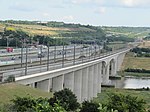Strood

Strood is a town in the unitary authority of Medway in Kent, South East England. The town forms a conurbation with neighbouring towns Chatham, Rochester, Gillingham and Rainham. It lies on the northwest bank of the River Medway at its lowest bridging point. Strood began as a manor then chapelry of Frindsbury until gaining its own parish status in 1193. Today Frindsbury is effectively, in all but a few associations such as in the Church of England, the northern part of Strood. Strood's history has been dominated by the river and facing port-associated towns, particularly its road and rail bridges since the Roman era to Rochester and the two other Medway Towns immediately adjoining and beyond from the north-east quarter of Kent to London and the rest of Britain. It has a mixed retail and leisure area at its heart. Most of its sources of employment are the other Medway towns, their associated commercial, industrial and logistics parks. Among its broadest named neighbourhoods are the "Earl estate" and Marlowe Park, one named after a house builder, the other after the grounds of a former mansion house.
Excerpt from the Wikipedia article Strood (License: CC BY-SA 3.0, Authors, Images).Strood
Elaine Avenue,
Geographical coordinates (GPS) Address Nearby Places Show on map
Geographical coordinates (GPS)
| Latitude | Longitude |
|---|---|
| N 51.393 ° | E 0.478 ° |
Address
Elaine Primary School
Elaine Avenue
ME2 2YN
England, United Kingdom
Open on Google Maps






